The Kick(in the teeth)starter
If ever there was a title for the most notorious Kickstarter in history, I cannot imagine a more fit contender than Moongha Invaders: Mad Scientists and Atomic Monsters Attack the Earth (Second Edition). The 71 campaign updates are a saga of awkward sadness whose ending, while technically “happy,” never seems to set the balance back in order.
I’m sure the 2010 first print came with its fair share of raised eyebrows. This B-movie setting and the ten-word title suggested a certain silliness that was perhaps atypical for Martin Wallace, but there was merit in the box—proof in the pudding, you might say. Moongha was well received. So much so that two years later, in October 2012, there was sufficient demand for a second run. Over 1100 backers jumped on board with $91,000, but instead of sealing a deal, they were opening a can of interstellar worms.
Gone were the vintage black and white design style and the bold red letters of the original in favor of full color madness and a delightful movie poster (even if it was folded for the sake of efficiency). Gone were the discs and tokens of the original in favor of MINIATURES—red, blue, green, yellow, and brown miniatures! Heroes, monsters, military artillery, and lots and lots of rubble! The upgrades and changes meant an anticipated delivery of July 2013.
By April 2013, the artists responsible for the sculpts had bailed, but a new company joined the project and hopes of an Essen release (October) remained strong. SPIEL came and went without a product. By December 2013, a new production company entered the scene and yet another set of molds followed. In March 2014, production shifted yet again to eventual manufacturing partner Panda.
It was June 2014 (11 months past the promised release date) before anyone saw images of the finished figures, but only after the price tag had escalated to nearly double the funds collected by the original campaign. Treefrog Games was suddenly relying on funds from other projects to finish the work on Moongha.

Communication gaffs and a host of tyrannical small issues later, Mr Wallace saw the first production copy in January of 2015 to many cheers from the peanut gallery. The print run finished in June of 2015, and copies reached their destination soil in September of 2015. Two SPIELS after the initial target, folks were purchasing Moongha even as unforeseeable shipping nightmares abounded the world over.
Eventually, the world had access to a few thousand copies of a fun little game with a less-than-fun Kickstarter story. I gather everyone involved remembers the campaign like one remembers a national catastrophe. Backers probably greet one another like soldiers who endured a common conflict. You were there, too? It wouldn’t surprise me if they all had a tattooed badge of retail honor.
Five years later, I picked up a gently used copy on the cheap just before the Moongha market bottomed out and the last copies were sold off for pennies on Amazon. What was once a $60 Kickstarter before shipping became a $9 shipped-to-your-door Prime deal. I’m not sure how my opinion would differ had I been through the hellish delays of the production process, but I’m glad for my copy. I likes what I likes, and I like Moongha.
Getting the (snow)ball rolling
In Moongha Invaders: Mad Scientists and Atomic Monsters Attack the Earth, you are “one of those sadistic, power-thirsty, psycho-nerds, eager for revenge” upon all who laughed at you. You are each mad scientists (in a slightly less serious bent than, say, My Father’s Work), attempting to raise a party of monsters bent on destruction more devastating than that of your opponents. Your goal is to leave Earth’s major cities in rubble while protecting only a select few that are apparently special to your heart.

Each player has access to seven different monsters, each with a particular usefulness in the quest for chaos. These monsters attack other monsters, the Heroes and Military outfits in their way, and the city at large according to their special skill set. Only three: the Bloob(s), Moogre, and Mechoor, are powerful enough to attack the city, but all have their moment in the sun across the eight or nine rounds of vengeful delight.
There are six possible actions in Moongha Invaders. A player’s turn simply involves claiming a token for the desired action and carrying it out. Specific numbers of actions will be available each round, which are then supplemented by a roll of an increasing number of dice. Four dice won’t set the world on fire in the first round, but rolling all twelve dice in the final rounds will. Make no mistake, this game is an avalanche.
The actions that benefit the monsters are: Create/Heal a monster, Attack (with a monster), and Move/Hide a monster. Players use these to build a modest army and exert influence across the map. Monsters prefer to remain hidden, marked by a small token, but must come into the light—via their, well, monstrous mini—to attack. Attacks are all dice driven, with 4-6 marking hits.

Players may also unleash human responses on their opponents’ monster madness as a means of furthering their own cause. Heroes are able to bring monsters out of the shadows, making them vulnerable to subsequent attack. Two Military actions release artillery: Infantry, Tanks, Jets, and the dreaded A-bomb. These artillery pieces attack as they enter the game. Some stick around to attack every time a monster rears its ugly head.
There is a wealth of minor details to these rules. Before a monster attacks the city, all artillery units first attack. Drakoor can only be attacked by Heroes and other Drakoors (even the nuke can’t get them!). Monsters are available to spawn again unless they are killed by a Moogre. Kiddoo is fairly weak, but wiry, so he can sneak in an attack on Heroes and Military before they launch their defensive strikes. Bloobs work in tandem, spreading their presence across multiple cities to launch broad attacks. Spectoor grants bonus movements. I could go on, but just know there are tactical considerations from start to finish that send you back to the rulebook until you gather a firm grasp.
The game escalates over eight rounds for four players or nine rounds for three players. (There is no solo mode and the two-player game is an entirely—and I mean entirely—different game, complete with a distinct board. It is so different that I would have to review it with a separate article altogether. Someday I may do just that.)

When the game ends, players score in four ways. Each city grants points to the player who laid the most rubble and, as long as there was no tie, second place as well. Drakoors who survive score points, but that score decreases based on the number of other monsters in the same city. They love privacy, you see. Players score based on the amount of rubble in their preferred cities—here less rubble is better. Finally, they score points for each monster destroyed by their Moogre. To the player with the most points go the spoils.
The pass(ive) action
The most interesting mechanic—and perhaps my favorite quirk—of Moongha is the Passing action. So often in games, the Pass is reserved for the end of a round to indicate the inability to continue. Passing often triggers some sort of end and/or grants a bonus (à la Tinners’ Trail or Petrichor) to the player who exercises the right first. Not so in this B-movie.
The Pass action is always available here because it’s not so much a traditional Pass as it is a short-term savings bond of chaos. Players may utilize their Pass action multiple times in every round if needed or desired. By placing the Pass token on one of the six actions, players indicate the action they’d like to perform on a future turn. There are no requirements that the space even be empty. They may then go on with business as usual until they decide to reclaim the Pass token, at which time they carry out the action. This may be back-to-back turns, or it may be that the token sits for most of a round before use.
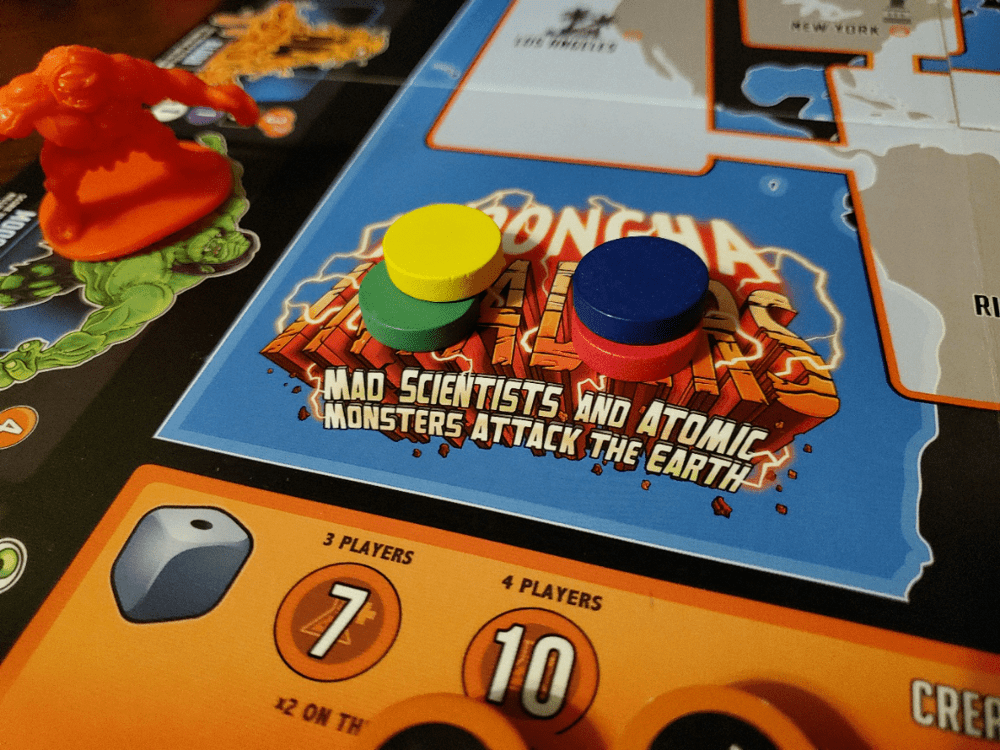
The catch (there’s always a catch) is that the trigger to end a round is when all players engage this Pass token consecutively. So in a four-player game, if all four players use the token—whether laying or reclaiming—in succession, the round ends. This trigger opens the door to potentially short rounds if players aren’t (or are) attentive.
I love this action because it enables the use of unavailable actions both early and late in the round, but at a cost of multiple turns. I also love this action because it allows for whimsy and head games. Bob placed his Pass token in Military II. That means he can grab a tank whenever he wants. If I bring my Mechoor out of hiding, he’ll come for me. Or will he? Fantastic.
The proper use of (military) time
The first few rounds of Moongha feel like setup because, in essence, they are. Players are deciding which monsters to cultivate while trying to sneak in a few bits of rubble here and there before the increased Military presence starts to provide real interference.
And Military interference is so much fun!! When an artillery piece first arrives in the city, it opens fire, along with every other artillery piece already in the city. With solid planning, the timely placement of a tank might instigate rolling eight or ten dice against one or several monsters. As the game rolls on and all these pieces enter the game, the entire world becomes an active warzone that you are simultaneously fighting against and exercising to the demise of others. It’s quite wonderful.
And the A-bomb. Oh my. There are two conventional ways the bomb enters the game. The first is by rolling four fives at the beginning of a round. The second is by rolling three sixes. Because the artillery enters the game progressively via the action spaces, the bomb only shows up once enough of the other pieces are also in play, making this little game changer rare. It’s possible you’ll never see one. It’s possible, like in our most recent play, to see multiple.

When the bomb drops, the attacking player first vacates all human presence from the city. They then roll eight dice against each monster—hidden or visible—in the city. After that devastation is finished, they also roll eight dice against the city itself. The bomb issues neutral brown rubble, which seems strange because it doesn’t benefit the player. Not directly anyhow. The benefit of the bomb is that it disrupts the area majority of others. In order to hold the majority, players’ rubble must also exceed the neutral brown. Nukes wreck plans. (Jets also unleash the brown rubble, but on a much smaller and more measured scale)
In one game, the outing that made him swear off Moongha forever, my son had loaded Tokyo with a bevy of his own monsters in preparation for world domination. My daughter helped us all to see just how much can go wrong in a single turn when she dropped the bomb, killing a half-dozen monsters, leveling the city, and ruining his endgame hopes. It was epic, even if it was the start of our first “family game blacklist.”
I watched a friend unleash the Military on herself, erasing her own weakened Mechoor to prevent one of us from swooping in with a Moogre to claim the massive endgame bonus. On the next turn, she shifted her strategy to Bloobs and very nearly came back to win through a series of calculated attacks. It was hilarious and brilliant.
One final stand(ing ovation)
I love me some Moongha Invaders. However, it is not a perfect game by any stretch of the imagination. With all the dice in play, the entire enterprise from start to finish is subject to fortune. Some of the best elements might never enter play because of the dice, so the trajectory can have a wild swing from one session to the next. Some folks will despise it. I find those qualities most endearing as they provide distinct flavor.
The roll of the dice at the beginning of any round issues a statement of sorts. A clump of 2’s will mean extra attacks. Extra 1’s might suggest a good round for creating Drakoors. An even distribution forces the evaluation of the moment to determine which action is most needed. A Military roll will undoubtedly change the face of the map. I enjoy the big market reveal.
Sometimes, despite having the beastly Mechoor locked and loaded, an abysmal roll of the dice will prevent taking the advantage in a city. Oh well. You have to be able to laugh about terrible luck. Sometimes you’ll work your tail off to get the right monster in the right place at the right time only to watch your friends—or former friends—send every Military installment on earth to your doorstep. Your opportunities might pop up and vanish again in a moment. Moongha is all about the quirky charm of wild possibilities.
Victory comes primarily from gaining those area majorities through the creation of rubble. But there is room to explore the proper placement of Drakoors and Moogre monster attacks as key strategies. At times, I’ve nearly won without having a major monster on the board for almost half a game. There are numerous ways to fruitfully engage the confusion.
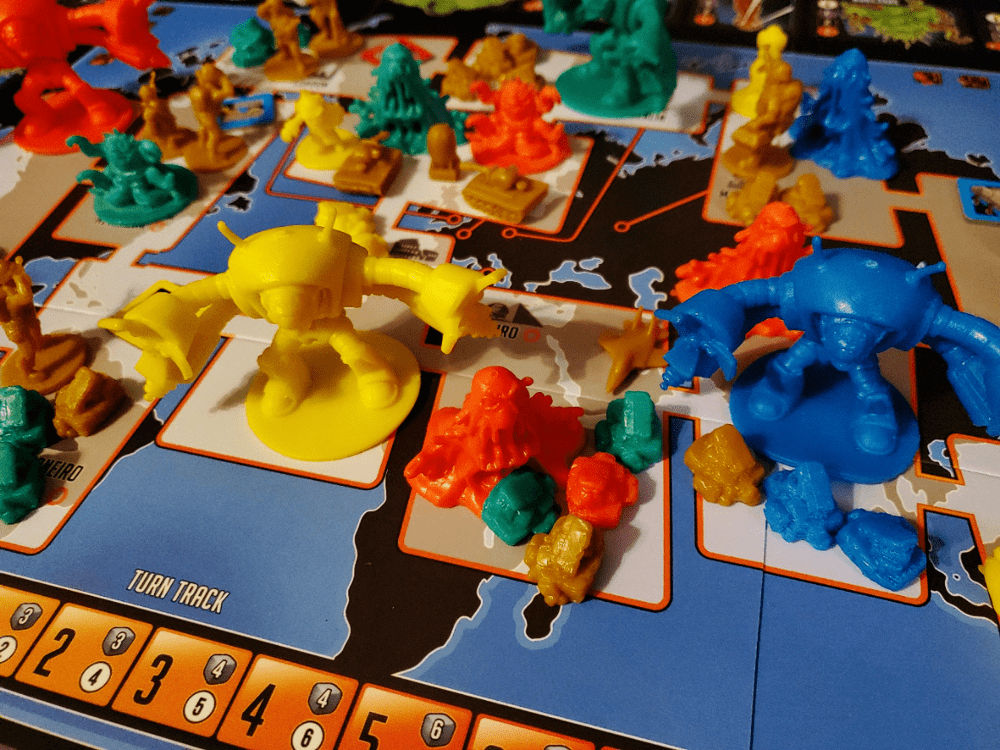
With regard to the components, I know there are many who preferred the old wooden tokens. There are many who criticize the questionable quality of the minis, especially for all the heartache they produced. Their arguments have merit. The miniatures are mediocre, cumbersome, and disproportionate on the board. During production, though, Mr Wallace celebrated the towering shadow they cast on the map as capturing the spirit. I happen to agree. A game like Moongha should proudly walk the tightrope of absurdity. The thematic content almost demands it. While strategy has a seat at the table, it is the glorious madness that makes me want to move the shoddy figures across the world, squeezing them into a city space that isn’t large enough to carry the load.
Extending the introductory horror story, many reported a pungent odor from the minis as well. Two copies have passed through our house without an olfactory offense, but I don’t doubt the tales. Fate seems to have had it in for this title. Mr Wallace closed up shop on Treefrog Games within a year of the debacle, choosing to focus exclusively on game design. Whatever stars these monsters arrived from, they weren’t aligned in favor of the game’s release.
Still, Moongha holds a very specific place in my collection. I play once, maybe twice a year. I would bring it out more often, but it almost requires a particular mood. With its infrequent stops on the table, we mix up a rule or two every time. Most recently, without thinking, we played that artillery units fired on every monster, every time (rather than only one). Was it technically wrong? Yes. Was it thematically acceptable? Sure. You better believe that a tank on the streets of Paris is not going to discriminate and save its shells when a trio of monsters starts wreaking havoc on the citizenry! We were too deep in to worry about correcting. We just let it rip. In the end, the outing was more destructive, and no one complained. The real value of these strange Invaders is not in the rigid adherence to inflexible rules in the name of achieving intellectual superiority, but in the capacity for creating memorable moments via impulsive devastation. I admire a game that survives, and occasionally thrives, because it creates an imaginative environment rather than an unforgiving framework.
As time passes, I hope Moongha Invaders: Mad Scientists and Atomic Monsters Attack the Earth continues to grow in legend and affection. It is an ill-omened feather in the cap of a very accomplished designer, and a bit of raucous fun for the thrill seeker who isn’t opposed to reveling in the avalanche when it rolls to the table.




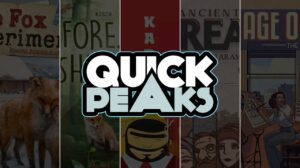
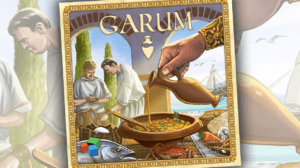

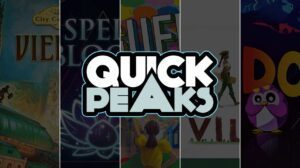




Add Comment